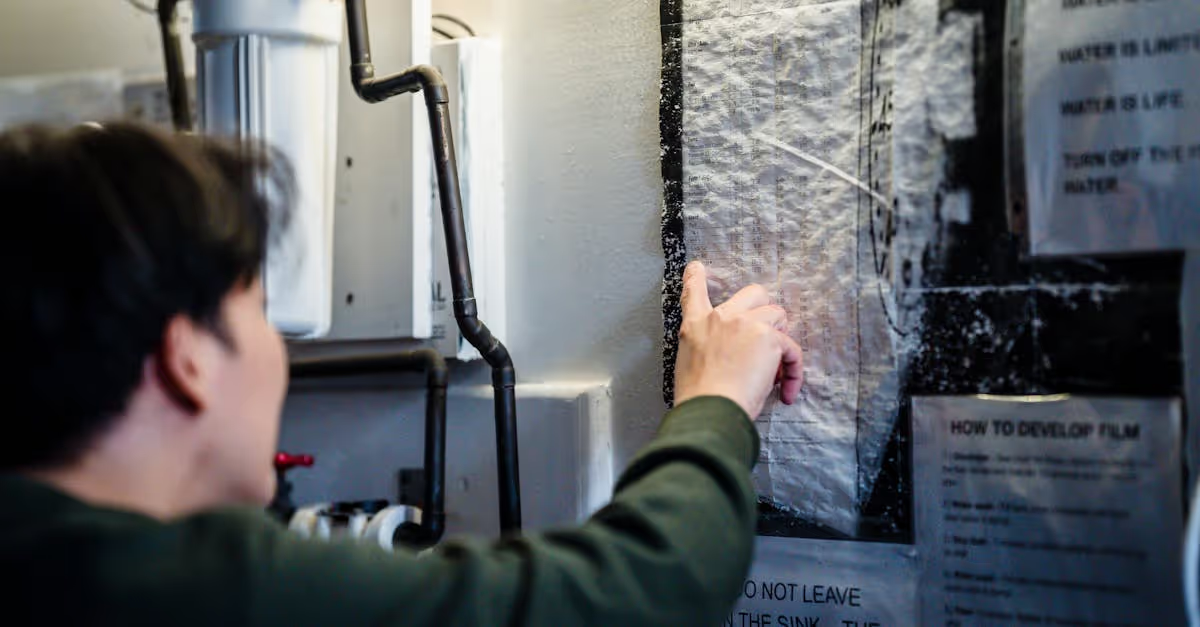Key Takeaways
- Regular Brushing is Crucial: Brush pool walls and steps at least once a week to prevent algae growth and maintain a clean swimming environment.
- Choose the Right Tools: Use appropriate brushes – nylon for vinyl pools, stainless steel for concrete, and corner brushes for hard-to-reach areas – to effectively combat algae.
- Effective Brushing Techniques: Employ strong, consistent strokes from top to bottom on walls and apply extra pressure on steps to stir up debris and promote circulation.
- Incorporate Additional Cleaning Tools: Utilize tools like pool vacuums, skimmer nets, algaecides, and test kits to enhance your cleaning routine and maintain proper chemical balance.
- Establish a Maintenance Routine: Develop a regular cleaning schedule and consistently check water chemistry to deter algae and ensure a safe swimming experience.
- Understand Algae Growth Conditions: Recognize that algae thrive in warm, moist areas, particularly in corners, and focus your brushing efforts there to disrupt their growth cycle.
Maintaining a sparkling clean pool isn’t just about aesthetics; it’s essential for the health of our swimming environment. Did you know that nearly 70% of pool owners struggle with algae growth at some point? This pesky invader can turn our serene oasis into a green nightmare if we don’t tackle it head-on.
Brushing the walls and steps of our pool regularly is a crucial step in preventing algae buildup. By utilizing effective techniques, we can ensure our pool remains inviting and safe for family and friends. In this guide, we’ll dive into the best practices for brushing our pool surfaces, helping us keep algae at bay and enjoy a pristine swimming experience all season long.
Importance of Brushing Pool Walls and Steps
Brushing pool walls and steps plays a critical role in maintaining a clean and enjoyable swimming environment. Regular brushing helps combat algae growth and keeps the pool looking inviting.
Preventing Algae Buildup
Preventing algae buildup requires consistent attention. We deal with algae in pools just like we deal with pesky weeds in our gardens. Regular brushing stirs up debris and particles that may harbor algae, disrupting their growth cycle. By using a good pool brush once a week, we can keep our pool’s surfaces clear, reducing the risk of algae taking hold. Remember that algae thrive in warm, moist areas, making the corners of pool walls prime real estate. By actively brushing these areas, we're not only removing potential breeding grounds but also promoting better water circulation. Is there a better feeling than diving into a green-free pool?
Recommended Tools and Equipment
Using the right tools and equipment makes brushing pool walls and steps efficient and effective. We’ll look at essential items to help combat algae buildup and maintain a pristine swimming environment.
Types of Pool Brushes
We recommend three main types of pool brushes:
- Nylon Brushes: Ideal for plaster or vinyl-lined pools. They gently scrub surfaces without risking damage.
- Stainless Steel Brushes: Perfect for fiberglass or concrete pools. They tackle stubborn debris and algae but require caution to avoid scratching.
- Corner Brushes: These specialized brushes reach tight spaces and corners. They help dislodge algae where it often hides.
Choosing the right brush for your pool type makes a big difference. Who hasn’t struggled with algae in the corners? A good brush can become your best ally.
Other Essential Cleaning Tools
Alongside brushes, several other tools enhance our cleaning routine.
- Pool Vacuum: Automatic vacuums can save time. They clean debris while you relax poolside.
- Skimmer Net: Essential for removing leaves and floating debris before they sink.
- Algaecide: This prevents algae growth. It effectively complements our brushing efforts.
- Test Kit: Regularly checking water balance helps maintain a healthy pool.
Effective Techniques for Brushing
Keeping our pool's walls and steps clean helps stop algae from making itself at home. Let's explore how simple brushing techniques can make a big difference.
Brushing Techniques for Walls
We start with the pool walls, where algae often lurk. To tackle this, we use strong, consistent strokes with our pool brush. Working from the top downward keeps debris from settling back onto cleaned sections. We focus on corners and other nooks where water flow is less constant. Brushing these areas disrupts potential growth sites and promotes better water circulation. Using a nylon brush for vinyl pools or stainless steel for concrete ensures we're using the right tool for the job. It’s a bit like washing a car; if we don’t scrub the hard-to-reach spots, dirt just keeps coming back. How often do we think about those tricky angles? Let's make it a habit to brush at least once a week for our pool’s health.
Brushing Techniques for Steps
Steps can be a favorite hangout for algae, so we can't overlook them. When brushing the steps, we apply a bit more pressure while making sure to get into the crevices. A corner brush can be handy here for those tight spots we tend to forget. Picture trying to clean the last bits of frosting from a baking pan; it requires precision and determination, right? Sliding our brush back and forth, we stir up the debris and send it floating to the surface, making it easier to vacuum later. Consistent attention to this area not only keeps our pool looking great but also provides a safer swimming experience for everyone. Let’s all commit to brushing our steps just like we would tidy up our homes. Together, we can enjoy a clean and inviting pool all season long.
Maintenance Tips
Maintaining pool cleanliness involves a few straightforward techniques that can make a big difference in preventing algae buildup. By establishing an effective routine, we not only keep our pools looking great but also promote safe swimming conditions.
Regular Cleaning Schedule
Setting a regular cleaning schedule becomes essential for effective pool maintenance. We recommend brushing the walls and steps at least once a week. This practice keeps debris from accumulating and disturbing any balance in water chemistry. Feel free to treat this like brushing your teeth—skip a week, and you risk plaque forming. Missing a cleaning session invites algae to settle in, particularly in hidden corners. Mark your calendar and see if including this task in our routine helps us spot algae before it becomes a bigger issue. How often do we currently brush our pools?
Chemical Balance and Its Role
Balancing pool chemicals plays a critical role in deterring algae growth. Maintaining the proper pH level (between 7.2 and 7.6) and ensuring chlorine levels stay between 1 to 3 parts per million keeps algae at bay. Think of it like cooking: the right measurements make a delicious dish, while incorrect ones can turn it into a disaster. If we’re not checking our chemicals weekly, we miss key signs that our pools might get out of hand. Regular testing with reliable kits allows us to adjust those parameters quickly. Let's check in: how often do we test our pool water?
Conclusion
By incorporating regular brushing into our pool maintenance routine we can significantly reduce the risk of algae buildup. This simple yet effective technique not only keeps our pool looking inviting but also ensures a healthier swimming environment. Choosing the right tools and applying the proper techniques will make our efforts even more successful.
Let’s remember that consistency is key. Committing to a weekly brushing schedule and monitoring water chemistry will help us maintain crystal-clear water throughout the season. With these practices in place we can enjoy our pools to the fullest while keeping algae at bay.
Frequently Asked Questions
Why is it important to maintain a clean pool?
Maintaining a clean pool is essential for aesthetic and health reasons. A dirty pool can lead to algae growth, which affects water quality and can cause skin irritations. Regular cleaning and brushing help ensure a safe and inviting swimming environment.
How often should I brush my pool?
It is recommended to brush your pool at least once a week. This regular practice helps prevent algae buildup and keeps the surfaces clear, particularly in warm, moist areas like the pool corners.
What type of brush should I use for my pool?
Choose your pool brush based on the type of pool surface: use nylon brushes for plaster or vinyl-lined pools, stainless steel brushes for fiberglass or concrete pools, and corner brushes for tight spaces.
What other tools do I need to maintain my pool?
In addition to a pool brush, consider using automatic vacuums, skimmer nets, algaecides, and test kits. These tools help in maintaining a clean and balanced swimming environment.
How do I establish a regular cleaning schedule?
Establishing a cleaning schedule involves setting a specific day each week for brushing your pool, similar to a daily routine like brushing teeth. Consistency is key to preventing debris accumulation and maintaining water chemistry.
How can I prevent algae growth in my pool?
To prevent algae growth, brush the walls and steps weekly, maintain proper chemical levels (pH and chlorine), and regularly test the water. This helps ensure safe swimming conditions and disrupts algae's growth cycle.






